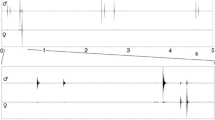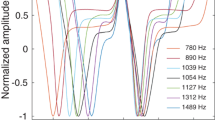Summary
-
1.
Stimulation of Eigenmannia with signals locked to various phases of the EOD cycle yielded a profile of phase sensitivity. A phase range where stimuli produced sharp increase of frequency could be distinguished from a range where frequency decrease was clicited (Figs. 2 and 3).
-
2.
The position of the boundaries between frequency accelerating and decelerating effects on the phase scale was dependent on the stimulus wave form (Figs. 2 and 3).
-
3.
Eigenmannia phase coupled its EOD to stimuli with a frequency difference (ΔF) below 1 Hz. Coupling occurred preferentially close to the beat maximum and to the minimum (Figs. 4 and 5).
-
4.
Coupling occurred starting from an initial positive or negative ΔF of the stimulus, though there were individual preferences for one or the other sign of the ΔF. Coupling was commonly terminated by a jamming-avoidance response (Figs. 4 and 5).
-
5.
Phase coupling was seen as well in two species of Apteronotus, in Sternopygus, and in the pulse fish Rhamphichthys. In all species there was a preference for particular phase ranges. Within the ranges, small phase oscillations were common (Fig. 6).
-
6.
All species showed coupling to Δ2 F signals (double frequency of the EOD); Eigenmannia and Sternopygus only coupled to Δ1/2 F signals (half the EOD frequency) if the stimulus wave form was adjusted to a normal EOD in that frequency range.
Similar content being viewed by others
References
Bastian, J.: Frequency response characteristics of electroreceptors in weakly electric fish (Gymnotoidei) with a pulse discharge. J. comp. Physiol. 112, 165–180 (1976)
Bullock, T.H.: Species differences in effect of electroreceptor input on electric organ pacemakers and other aspects of behavior in electric fish. Brain Behav. Evol. 2, 85–118 (1969)
Bullock, T.H., Hamstra, R.H., Jr., Scheich, H.: The jamming avoidance response of high frequency electric fish. I and II. J. comp. Physiol. 77, 1–48 (1972)
Heiligenberg, W.: Principles of electrolocation and jamming avoidance in electric fish. Studies of brain function, Vol. 1, Berlin, Heidelberg, New York: Springer 1977
Heiligenberg, W., Baker, C., Bastian, J.: The jamming avoidance response in gymnotid pulse species: A mechanism to minimize the probability of pulse-train coincidence. J. comp. Physiol. 124, 211–224 (1978)
Hopkins, C.D.: Electric communication in the reproductive behavior of Sternopygus macrurus Gymnotoidei. Z. Tierpsychol. 35, 518–535 (1974)
Kramer, B.: Electric organ discharge interaction during interspecific agonistic behavior in freely swimming mormyrid fish. A method to evaluate two (or more) stimultaneous time series of events with a digital analyzer. J. comp. Physiol. 93, 203–236 (1974)
Langner, G., Scheich, H.: Active phase coupling in electric fish: Behavioral control with microsecond precision. J. comp. Physiol. 128, 235–240 (1978)
Larimer, J.L., MacDonald, J.A.: Sensory feedback from electroreceptors to electromotor pacemaker centers in gymnotids. Am. J. Physiol. 214, 1253–1261 (1968)
MacDonald, J.A., Larimer, J.L.: Phase sensitivity of Gymnotus carapo to low amplitude electrical stimuli. Z. vergl. Physiol. 70, 322–334 (1970)
Russell, C.J., Meyers, J.P., Bell, C.C.: The echo-response in Gnathonemus petersii (Mormyridae). J. comp. Physiol. 92, 181–200 (1974)
Scheich, H.: Neural basis of communication in the high frequency electric fish, Eigenmannia virescens (jamming avoidance response) I, II, III. J. comp. Physiol. 113, 181–255 (1977)
Scheich, H., Bullock, T.H.: The role of electro-receptors in the animal's life. II. The detection of electric fields from electric organs. In: Handbook of sensory physiology, Vol. 3. Fessard, A. (ed.). Berlin, Heidelberg, New York: Springer 1974
Scheich, H., Gottschalk, B., Nickel, B.: Principles of electrosensory interference with the pacemaker in harmonic and pulse-gymnotics. Proc. XXVII th International Congress of Physiol. Sciences, Paris, p. 666 (1977a)
Scheich, H., Gottschalk, B., Nickel, B.: The jamming avoidance response in Rhamphichthys rostratus: An alternative principle of time domain analysis in electric fish. Exp. Brain Res. 28, 229–233 (1977b)
Watanabe, A., Takeda, K.: The change of discharge frequency by A.C. stimulus in a weak electric fish. J. Exp. Biol. 40, 57–66 (1963)
Westby, G.W.M.: Has the latency-dependent response of Gymnotus carapo to discharge-triggered stimuli a bearing on electric fish communication? J. comp. Physiol. 96, 307–341 (1975a)
Westby, G.W.M.: Comparative studies of the aggressive behavior of two gymnotid electric fish (Gymnotus carapo and Hypopomus artedi). Anim. Behav. 23, 192–213 (1975b)
Author information
Authors and Affiliations
Additional information
Supported by the Deutsche Forschungsgemeinschaft Sche 132/2, Sche 132/3, Sche 132/4. To whom reprint requests should be sent
Rights and permissions
About this article
Cite this article
Gottschalk, B., Scheich, H. Phase sensitivity and phase coupling: Common mechanisms for communication behaviors in gymnotid wave and pulse species. Behav Ecol Sociobiol 4, 395–408 (1979). https://doi.org/10.1007/BF00303245
Received:
Issue Date:
DOI: https://doi.org/10.1007/BF00303245




